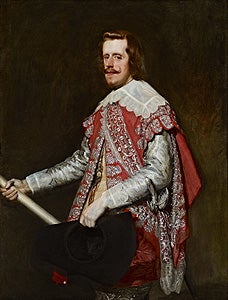The King at War: Velázquez's Portrait of Philip IV
October 26, 2010, through January 23, 2011
| |
 |
|
|
| |
Diego Rodríguez de Silva y Velázquez (1599–1660), King Philip IV of Spain,1644, oil on canvas, 51 1/8 x 39 1/8 inches, The Frick Collection, New York |
|
|
Painted at the height of Velázquez's career, the Frick's King Philip IV of Spain (1644) is one of the artist's consummate achievements. Contemporary chronicles as well as bills and invoices in Spanish archives indicate that it was painted in a makeshift studio only a few miles from the frontlines of a battle, and that it was completed in just three sittings. The work, which shows its subject dressed in military costume, an atypical depiction, was sent to Madrid where it was used during a victory celebration. Displayed in a church under a rich canopy embroidered in gold, the painting embodied the contemporary idea of monarchy as the divinely sanctioned form of government.
In conjunction with a focus on Spanish art this fall with the exhibition The Spanish Manner: Drawings from Ribera to Goya, the Frick offers a dossier presentation on the portrait, which returned recently from The Metropolitan Museum of Art, having been cleaned for the first time in more than sixty years. The gleaming silver brocade covering the king's crimson cassock is executed in a shockingly free and spontaneous manner, which is almost unparalleled in the painter's production and can now be better appreciated. The treatment by Michael Gallagher, Sherman Fairchild Conservator in Charge of Paintings Conservation, revealed the dazzling original surface that had been veiled by a yellowing varnish. Additionally, the first technical studies of the painting were undertaken, involving microscopy, X-radiography, and infrared reflectography.
Coordinated by Andrew W. Mellon Curatorial Fellow Pablo Pérez d'Ors, the Frick's presentation places the restored masterpiece in the context of original research and findings resulting from its recent cleaning and examination. It also sheds new light on the function of the painting and the implications of presenting the king as a soldier, while addressing connections between the portrait and other paintings by the artist and his workshop. A thrilling mixture of Spanish Baroque art, politics, war, and religion comes alive at the Frick through examination of this masterpiece.
The exhibition is made possible by The Andrew W. Mellon Foundation |


